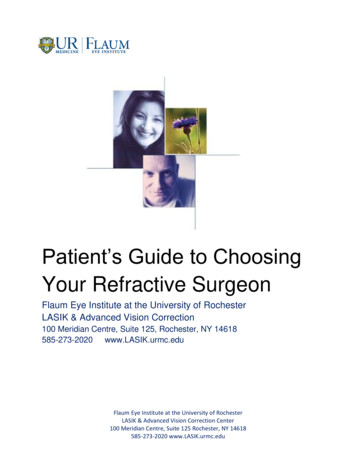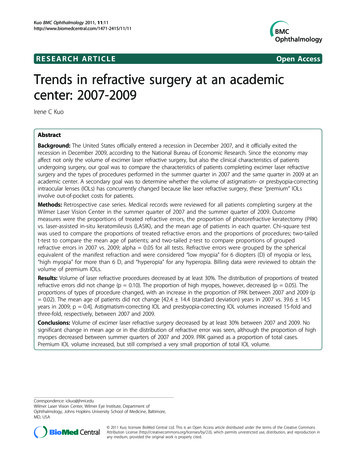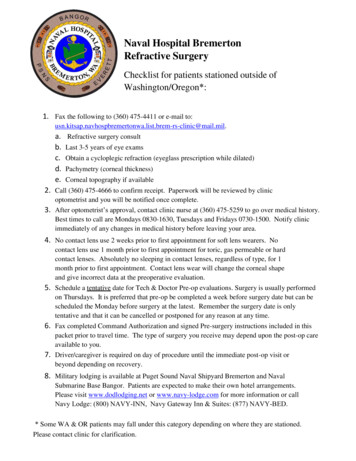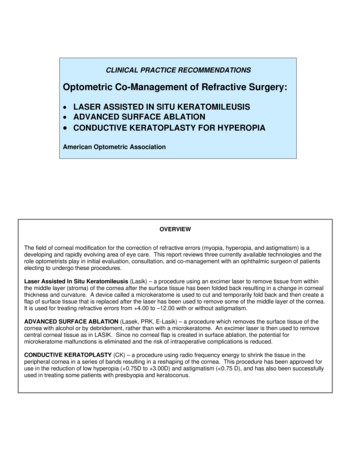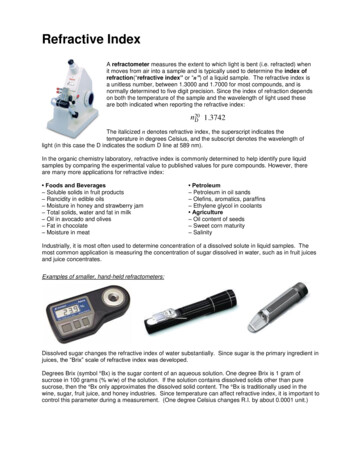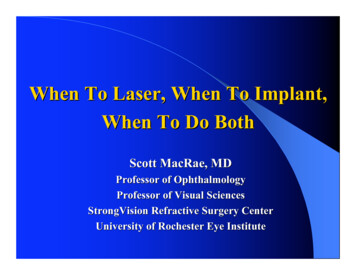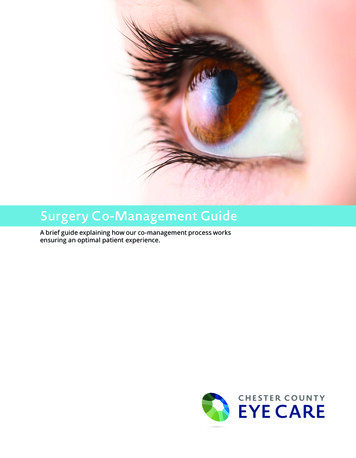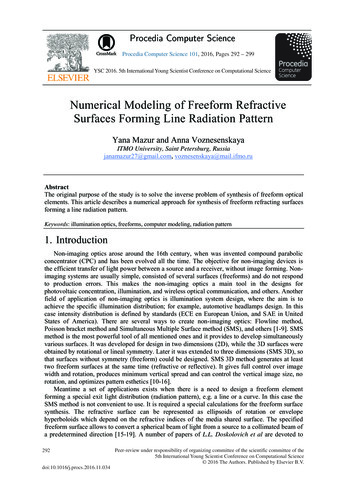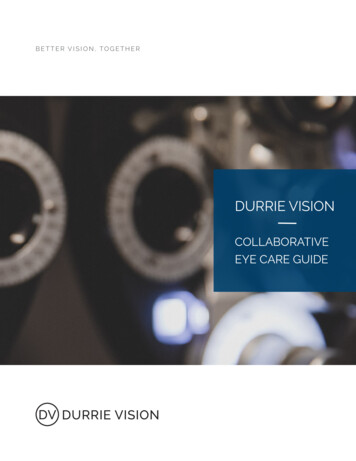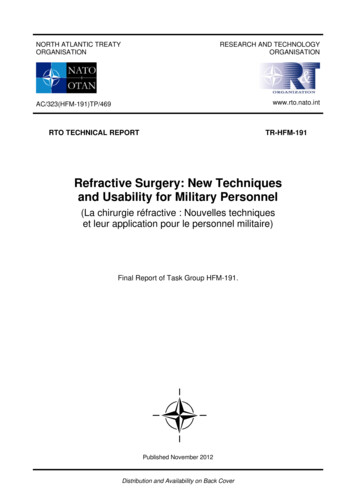
Transcription
NORTH ATLANTIC TREATYORGANISATIONRESEARCH AND 91)TP/469RTO TECHNICAL REPORTTR-HFM-191Refractive Surgery: New Techniquesand Usability for Military Personnel(La chirurgie réfractive : Nouvelles techniqueset leur application pour le personnel militaire)Final Report of Task Group HFM-191.Published November 2012Distribution and Availability on Back Cover
NORTH ATLANTIC TREATYORGANISATIONRESEARCH AND 91)TP/469RTO TECHNICAL REPORTTR-HFM-191Refractive Surgery: New Techniquesand Usability for Military Personnel(La chirurgie réfractive : Nouvelles techniqueset leur application pour le personnel militaire)Final Report of Task Group HFM-191.
The Research and TechnologyOrganisation (RTO) of NATORTO is the single focus in NATO for Defence Research and Technology activities. Its mission is to conduct and promoteco-operative research and information exchange. The objective is to support the development and effective use ofnational defence research and technology and to meet the military needs of the Alliance, to maintain a technologicallead, and to provide advice to NATO and national decision makers. The RTO performs its mission with the support of anextensive network of national experts. It also ensures effective co-ordination with other NATO bodies involved in R&Tactivities.RTO reports both to the Military Committee of NATO and to the Conference of National Armament Directors.It comprises a Research and Technology Board (RTB) as the highest level of national representation and the Researchand Technology Agency (RTA), a dedicated staff with its headquarters in Neuilly, near Paris, France. In order tofacilitate contacts with the military users and other NATO activities, a small part of the RTA staff is located in NATOHeadquarters in Brussels. The Brussels staff also co-ordinates RTO’s co-operation with nations in Middle and EasternEurope, to which RTO attaches particular importance especially as working together in the field of research is one of themore promising areas of co-operation.The total spectrum of R&T activities is covered by the following 7 bodies: AVTApplied Vehicle Technology PanelHFMHuman Factors and Medicine PanelISTInformation Systems Technology PanelNMSG NATO Modelling and Simulation GroupSASSystem Analysis and Studies PanelSCISystems Concepts and Integration PanelSETSensors and Electronics Technology PanelThese bodies are made up of national representatives as well as generally recognised ‘world class’ scientists. They alsoprovide a communication link to military users and other NATO bodies. RTO’s scientific and technological work iscarried out by Technical Teams, created for specific activities and with a specific duration. Such Technical Teams canorganise workshops, symposia, field trials, lecture series and training courses. An important function of these TechnicalTeams is to ensure the continuity of the expert networks.RTO builds upon earlier co-operation in defence research and technology as set-up under the Advisory Group forAerospace Research and Development (AGARD) and the Defence Research Group (DRG). AGARD and the DRG sharecommon roots in that they were both established at the initiative of Dr Theodore von Kármán, a leading aerospacescientist, who early on recognised the importance of scientific support for the Allied Armed Forces. RTO is capitalisingon these common roots in order to provide the Alliance and the NATO nations with a strong scientific and technologicalbasis that will guarantee a solid base for the future.The content of this publication has been reproduceddirectly from material supplied by RTO or the authors.Published November 2012Copyright STO/NATO 2012All Rights ReservedISBN 978-92-837-0170-5Single copies of this publication or of a part of it may be made for individual use only. The approval of the RTAInformation Management Systems Branch is required for more than one copy to be made or an extract included inanother publication. Requests to do so should be sent to the address on the back cover.iiRTO-TR-HFM-191
Table of ContentsPageList of TablesvList of s of ReferencexiAcknowledgementsxiiiHFM-191 Membership ListxivExecutive Summary and SynthèseES-1Chapter 1 – Introduction1-11.11-11-11-1Origin of the Technical Activity1.1.1Background and Justification (Relevance to NATO)1.1.1.1ObjectivesChapter 2 – Technique 32-32.22.3Corneal Refractive Surgery2.1.1Surface Ablation Techniques2.1.2LASIK2.1.3Thermokeratoplasty / Conductive Keratoplasty2.1.4Intrastromal Rings2.1.5Multi-Focal Corneal AblationsIntraocular Surgery2.2.1Clear Lens Extraction2.2.2Phakic Intraocular Lenses2.2.3Accommodative Intraocular Lenses2.2.4Multi-Focal Intraocular LensesAdjunctive Technology2.3.1Wavefront Measurement2.3.2Femtosecond LaserChapter 3 – Military CRS Policy3-13.13-13-1Military Policy on Refractive Surgery3.1.1Member State PoliciesRTO-TR-HFM-191iii
Chapter 4 – Vision Assessment Methods4-14.14.24.34.44-14-14-14-2Basic Visual AssessmentAdditional Tests of Visual FunctionSpecial InvestigationsPost-Operative Visual PerformanceChapter 5 – Conclusions5-15.1Further Study5-1Chapter 6 – References6-1ivRTO-TR-HFM-191
List of TablesTablePageTable 1-1Techniques and Technologies1-1Table 3-1Techniques and Technologies per Member State: Belgium3-1Table 3-2Techniques and Technologies per Member State: Canada3-2Table 3-3Techniques and Technologies per Member State: Denmark3-2Table 3-4Techniques and Technologies per Member State: France3-3Table 3-5Techniques and Technologies per Member State: Germany3-3Table 3-6Techniques and Technologies per Member State: Greece3-4Table 3-7Techniques and Technologies per Member State: Italy3-5Table 3-8Techniques and Technologies per Member State: Netherlands3-5Table 3-9Techniques and Technologies per Member State: Norway3-6Table 3-10Techniques and Technologies per Member State: Portugal3-7Table 3-11Techniques and Technologies per Member State: Slovenia3-7Table 3-12Techniques and Technologies per Member State: Spain3-8Table 3-13Techniques and Technologies per Member State: Sweden3-9Table 3-14Techniques and Technologies per Member State: United Kingdom3-9Table 3-15Techniques and Technologies per Member State: United StatesRTO-TR-HFM-1913-10v
List of AcronymsEpi-LASIKEpithelial laser-assisted in situ keratomileusisLASEKLaser epithelial keratomileusis (also known as Laser sub-epithelial keratectomy)LASIKLaser-assisted in situ keratomileusisPRKPhotorefractive keratectomyviRTO-TR-HFM-191
Nomenclature Accommodation: Ability of the eye to change focal point distances from far to near due to physiologicincreases in curvature and thickness of the lens within the eye. Accommodative IOL: An artificial lens that permits a small amount of change of focus. Chromophore lens: Lens with light filtering capacity. Corneal epithelium: The outer layer of the cornea, consisting of about 6 layers of cells attached to abasement membrane. Corneal ectasia: Progressive pathologic corneal thinning and bulging; causes uncorrectable poorvision. Corneal haze: clouding of the outer surface of the cornea following surface ablation refractivesurgery procedures; caused by under-controlled post surgery inflammatory response. Corneal stroma: The middle and thickest layer of the cornea, typically around 500 µm in the center,giving the cornea its strength. It consists of highly organized lamellae of parallel collagen fibrils. Excimer laser: Computer controlled ultraviolet laser that shapes tissue by photoablative DEcompensation of molecular bonds. It is used for both surface ablation and LASIK. Femtosecond laser: Ultrashort infrared wavelength laser that incises tissue by vaporisation. Its use inrefractive surgery is to create the LASIK flap. Intraocular surgery: Placing an artificial lens inside the eye to correct the refractive error. This canbe done by extracting the natural lens (CLE), or by leaving the natural lens intact (phakic IOL, alsoknown as ICL) depending on the size of the refractive error. Keratomileusis: Corneal shaping. Keratoplasty: Surgical replacement of a portion of the cornea with a piece of cornea of the same sizeand shape. Also called corneal graft. Keratectomy: Excision of a portion of the cornea. LASIK: A partial thickness corneal flap (typically 90 to 160 µm) is created and lifted prior to stromaltissue ablation with the excimer laser. The flap is then placed back over the ablated cornea. Monovision: One eye corrected for maximal distance acuity and one eye corrected for near vision. Multi-focal IOL: An artificial lens which permits an extended range of vision by virtue of havingmore than 1 point of focus. Radial keratotomy: An early refractive surgical technique in which deep radial incisions were madewith a diamond blade into the cornea to flatten its curvature. Surface ablation: In techniques such as PRK and LASEK, a layer of cells called the corneal epithelium,approximately 50 µm thick, is first removed. The excimer laser is then used to reshape the anteriorsurface of the cornea.RTO-TR-HFM-191vii
PrefaceIn surface ablation techniques such as PRK, Epi-LASIK and LASEK, a layer of cells called the cornealepithelium is first removed. Excimer laser is then used to reshape the anterior surface of the cornea. In LASIK,a partial thickness corneal flap is created and lifted prior to the anterior surface ablation with the excimer laser.The flap is placed back over the ablated cornea. Intraocular surgery may also entail placing a lens inside the eyeto correct the refractive error.Over the last 20 years, unprecedented changes have occurred in the domain of eye surgery. Specifically,the way that refractive errors are treated has undergone a revolution with the advent of lasers that can reshapethe cornea. The technology has undergone a series of step changes so that it is now recognised as being one ofthe safest elective procedures available. Hundreds of thousands of military personnel have undertaken to havecorneal refractive surgery in recent years with extremely high levels of satisfaction. However, soldiers andcommanders alike have a limited understanding of the different procedures available, the risks to the eye andthe impact on occupational vision standards. Moreover, the importance of a fully informed pre-operativeassessment and a comprehensive postoperative care are sometimes underestimated. This technical report seeksto clarify the issues surrounding military refractive surgery.viiiRTO-TR-HFM-191
ForewordThe excimer laser represented a paradigm shift in refractive surgery when it was introduced in the late 1980s.This unique ultraviolet laser was able to sculpt the cornea with a microscopic precision not previously seen andwithout causing underlying tissue damage. Under computer control, the laser could remove a small lenticule oftissue matched precisely to correct a refractive error. This technique was collectively termed Laser VisionCorrection (LVC) and refers to all refractive uses of the excimer laser, such as Photorefractive Keratectomy(PRK) and Laser In-Situ Keratomileusis (LASIK). LVC was a significant improvement over previous refractivetechniques, such as Radial Keratotomy (RK). RK was quickly rejected for use in operational forces fornumerous reasons that were related to the deep corneal incisions intrinsic to the procedure, such as diurnalfluctuation in vision. With the seeming advantages of the excimer laser, military ophthalmologists andresearchers began evaluating defence force implications of laser vision correction almost 20 years ago. Throughhundreds of studies, a high level of safety and effectiveness of LVC in operational environments becameapparent. A careful review of the risks and benefits of LVC by senior officials led to the US DoD WarfighterRefractive Surgery Program in 1999 and the creation of dozens of military treatment centers around the world.Today well over 100,000 service personnel have undergone LVC to reduce or eliminate their need for opticalcorrection. Military services have enjoyed tremendous success primarily because LVC can increase the combateffectiveness of a fighting force. Examples are numerous. Glasses are not compatible with many of today’sspecialized weapon systems which require headgear, such as night vision goggles, helmet mounted targetingsights and chemical/biologic protective headgear. None of them perform at optimal levels in conjunction withglasses. Problems include restricted peripheral vision, fogging, incompatibility with swimming/diving,discomfort during prolonged wear, displacement during positive acceleration ( Gz), and reduced clarity ininclement weather. While contact lenses have generally been well received, they can have significantoperational problems also. Intolerance to soft contact lenses limits their usefulness, particularly in hot, dusty,or dry environments. Soft lenses are incompatible with chemical/biological headgear. Routine lens hygiene isimpractical or impossible during field operations causing personnel to abandon them or extend their wearpattern and risk added complications. Replacement lenses can be difficult to obtain while deployed.Besides the significant advantages of improving combat effectiveness, we have observed numerous otheradvantages of performing LVC in the military, some of these are listed below:1) Improved combat readiness. The requirement to maintain optical appliances (spectacles and gas-maskinserts) is an essential component of readiness for combat. By reducing or eliminating the need foroptical correction, LVC has had a direct and positive impact on the readiness status of combat forces.2) Increasing the applicant pool. Highly qualified candidates, who were previously excluded because ofrefractive limits, are now allowed to apply and serve in a variety of occupations. As an example, over10% of students entering Naval flight training previously underwent LVC. Their selection for flighttraining was based on their potential to become effective combat pilots when judged against their peers.3) Improved vision. In many individuals, LVC improves vision better than could be achieved beforesurgery with glasses or contact lenses. This can further enhance combat effectiveness.4) Enhanced quality of life. This is a near universal observation in patients who have undergonesuccessful refractive surgery. Improving the quality of life of a fighting force is not just a noble goal;it can also significantly improve morale and retention.There have been significant technologic advances in LVC since the Warfighter Refractive Surgery Programwas established over 10 years ago. This includes the femtosecond laser for the LASIK flap creation, aberrometrydevices to measure all ocular aberrations and wavefront guided procedures which can correct these aberrations.Military researchers have been at the forefront of evaluating these technologies and incorporating successfulinnovations into clinical practice. Continued research in this regard is vital to ensure that service personnel areoffered the best and most appropriate procedures in the future.RTO-TR-HFM-191ix
We have entered a new era with the introduction of LVC in military forces with its demonstrated ability toreduce the need for optical appliances while maintaining a high level of safety and accuracy. It adds significantand profound value to modern military medicine by not just returning injured personnel to health, but to helpthem perform their jobs better.Steve Schallhorn, MD, USN, CAPT (retired)xRTO-TR-HFM-191
Terms of ReferenceI.ORIGINA.BackgroundManagement of refractive errors in military personnel is an important operational issue. New surgicaltechniques continue to emerge that may provide benefit in managing and correcting refractive errors as well asenabling the expansion of the military applicant pool. A published report of the current surgical techniquesavailable as well as a thorough discussion of the risks and related performance benefits of these procedures onmilitary members is warranted. In Photorefractive Keratectomy (PRK) and its variant surface ablationtechniques, the corneal epithelium is first removed and the excimer laser then used to reshape the anteriorsurface of the cornea. In LASIK, a partial thickness corneal flap is created and lifted prior to the anteriorsurface ablation with the excimer laser. The flap is placed back over the treated cornea following the ablation.PRK, LASIK and other technologies and techniques are increasingly being performed by some NATO militaryservices on its members and is commonly performed in the civilian community. For some military services,both PRK and LASIK are allowed, some allow only PRK, and some do not allow either. Other refractivesurgery procedures should be carefully evaluated for the safety and efficacy in the military environment.B. Justification (Relevance for NATO)Management of refractive errors in military personnel is an important operational issue. New surgicaltechniques continue to emerge that may provide benefit in managing and correcting refractive errors as well asenabling the expansion of the military applicant pool.II. OBJECTIVES1) Publish a technical report that reviews the clinical risks and benefits regarding PRK, LASIK, and otheravailable refractive surgery procedures and the usability of each in military personnel without diminishingoperational effectiveness; update report annually as applicable.2) Publish a technical report that reviews available refractive surgery outcome and quality of vision assessmentmethodologies and the usability of each in military personnel; update report annually as applicable.3) Publish a summary report of the current refractive surgery policy of each NATO member nationparticipating in this Technology Working Group (Watch Group); update report annually as applicable.III. RESOURCESA. MembershipChairman: To Be Determined.Lead Nation: United States.Nations Willing/Invited to Participate: Belgium, Canada, France, Germany, Italy, Netherlands, Norway, Spain,Turkey, United Kingdom, United States.B.National and/or NATO Resources NeededMeeting facility.Audiovisual and administrative support.RTO-TR-HFM-191xi
C. RTA Resources NeededConsultant funding travel expenses for some countries.IV. SECURITY CLASSIFICATION LEVELThe security level will be Unclassified/Unlimited.V.PARTICIPATION BY PARTNER NATIONSAll partners (PfP, MD and preferred Contact Countries) invited.PfP Nations: All PfP invited.MD Nations: All MD invited.ICI Nations: None.Contact Nations: Australia, Japan, New Zealand.xiiRTO-TR-HFM-191
AcknowledgementsSpecial thanks for contributions to this technical report made by: Dr. (Lt Col) Daniel Emonds (Belgium) Dr. (Col) Bruce Bain (Canada) Dr. (Col) Scott McLeod (Canada) Dr. Pat Hinton (Canada) Dr. (Maj) Jan Nybo Nielsen (Denmark) Dr. Andreas Patelis (Greece) Dr. Claudia Stern (Germany) Dr. (Col) Dario Di Blasio (Italy) Dr. D.F. Schaling (Netherlands) Dr. Larisa Pograjc (Slovenia) Dr. (Col) Francisco Rios-Tejada (Spain) Dr. Rene’ Svensson (Sweden) Dr. (CAPT, ret) Steve Schallhorn (United States) Dr. (Col, ret) Douglas Ivan (United States)RTO-TR-HFM-191xiii
HFM-191 Membership ListFRANCECol. Dr. J.C. RIGAL-SASTOURNEEmail: rigal-sastourne@noos.frUNITED KINGDOMMaj. Dr. Gerry CLAREEmail: gc.island@gmail.comGERMANYLTC. Dr. Detlef DEIERMANNEmail: DetlefDeiermann@bundeswehr.orgUNITED STATESCol. Dr. Scott BARNESEmail: Scott.D.Barnes@amedd.army.milCOL. Dr. Joerg FRISCHMUTHEmail: JoergFrischmuth@bundeswehr.orgCol. Dr. Scot BOWEREmail: Kraig.Bower@amedd.army.milDr. Peter MEESEmail: PeterMees@bundeswehr.orgCol. Dr. John GOOCH (Chair)Email: john.gooch@wpafb.af.milNORWAYDr. Bente HAUGHOMEmail: bente.haughom@medisin.uio.noCAPT. Dr. Stephen O’CONNELLEmail: stephen.oconnell@NAMI.navy.milPORTUGALMaj. Dr. Sofia ALMADAEmail: sofiaalmada@gmail.comLtCol. Dr. Charles REILLYEmail: Charles.Reilly@lackland.af.milCAPT. Dr. David TANZEREmail: David.Tanzer@med.navy.milMaj. Dr. Maria LAUREANOEmail: fatimalaureano@gmail.comSPAINMaj. Dr. Beatriz PUENTEEmail: bpueesp@oc.mde.esxivRTO-TR-HFM-191
Refractive Surgery: New Techniquesand Usability for Military Personnel(RTO-TR-HFM-191)Executive SummaryIssueCorneal surgery to correct refractive errors is highly relevant to military organizations for 3 main reasons.Firstly, by improving uncorrected distance visual acuity, refractive surgery can enable recruits or enlistedpersonnel to meet uncorrected vision standards for military occupations of their choosing, expanding theapplicant pool and enabling individuals to achieve their ambitions. Second, alternative correctivemeasures, such as contact lenses and spectacles, are not well suited to hostile operational environmentsand certain military activities and equipment. Thus, refractive surgery in military personnel can enhanceoperational effectiveness. Third, complicated or inappropriate refractive procedures can cause visualdisability and curtail military careers. For this reason, the quality of the service provision should beensured. Techniques are undergoing constant refinement and innovation, yet the value of new advances inrefractive surgery may not be immediately obvious. There is currently no uniformity of policy with respectto refractive surgery in military personnel across NATO.PurposeThe purposes of this report are to outline the different techniques of refractive surgery available,to evaluate the different approaches to military refractive surgery taken by participating member states andto list the methods for evaluating quality of vision after refractive surgery.ScopeThe scope of this technical report is limited to the current policies of participating member countries,which includes permitted refractive surgical procedures, service provisions and constraints within eachstate. Ophthalmologists and flight surgeons attached to military service providers from participatingNATO member countries and Partners for Peace were invited to submit information regarding refractivesurgery in their Armed Forces.LimitationsOnly those countries for which a serving ophthalmologist or flight surgeon was consulted are included inthis report, including Belgium, Canada, Denmark, France, Germany, Greece, Italy, Netherlands, Norway,Portugal, Slovenia, Spain, Sweden, the United Kingdom and the United States. It must be stressed that theguidelines and regulations on refractive surgery are effective only insofar as organisations and individuals areprepared to adhere to them. Many service ophthalmologists have witnessed at first hand the consequences offailure to follow the guidelines set out by the occupational health advisers to military organisations.ConsiderationsThe risks and benefits of refractive surgical procedures are highlighted, with contributions from a panel ofService (or civilian attached) ophthalmologists from NATO member states. The financial costs ofrefractive surgery are not considered in this report.RTO-TR-HFM-191ES - 1
Analysis/ResultsThere is heterogeneity of the degree of service provision and the range of permissible procedures acrossNATO countries. Clinical governance in refractive surgery is often unsatisfactory, especially in countrieswhere service provision is meagre. This can result in unacceptable procedures being carried out byexternal providers, or in health care management deviations that produce unacceptably high risks forrefractive surgery patients.Recommendations for Further StudyFurther assessment of the risks and benefits of refractive surgical procedures among military occupationalgroups is needed. A cost-benefit analysis of a refractive surgical service to military organisations isrecommended to member states. It is recommended that the cost of inadequate clinical governance inrefractive surgery be factored into the overall evaluation.ES - 2RTO-TR-HFM-191
La chirurgie réfractive : Nouvelles techniqueset leur application pour le personnel s opérations chirurgicales de la cornée destinées à corriger les erreurs de réfraction sont d’un grand intérêtpour les organisations militaires, et ce pour 3 grandes raisons. En premier lieu, en améliorant l’acuité visuellede loin sans correction, la chirurgie réfractive permet aux jeunes recrues ou militaires du rang de satisfaireaux normes de vision sans correction exigées pour le métier militaire de leur choix, d’où une augmentationdu nombre de candidats et la possibilité pour les individus d’atteindre leurs ambitions. En second lieu,les mesures alternatives de correction, comme les lentilles de contact ou les lunettes, ne sont pas bienadaptées à un environnement opérationnel hostile ni à certains matériels ou activités militaires.Par conséquent, le recours à la chirurgie réfractive pour le personnel militaire peut améliorer l’efficacitéopérationnelle. En troisième lieu, des interventions compliquées ou inappropriées de chirurgie réfractiverisquent d’engendrer des handicaps visuels et d’écourter des carrières militaires. Pour cette raison, la qualitédu service fourni doit être garantie. En dépit de constants perfectionnements et innovations techniques,l’intérêt de nouvelles avancées en chirurgie réfractive peut ne pas sauter aux yeux. Il n’existe à l’heureactuelle aucune uniformité des politiques concernant la chirurgie réfractive du personnel militaire au sein del’OTAN.ObjectifLes objectifs de ce rapport sont de définir les différentes techniques de chirurgie réfractive disponibles,d’évaluer les différentes approches de chirurgie réfractive militaire entreprises par les Etats membres et derépertorier les méthodes d’évaluation de la qualité de la vision après une chirurgie réfractive.PortéeLa portée du présent rapport technique se limite aux politiques actuelles des Etats membres participants,incluant les procédés autorisés de chirurgie réfractive, les services offerts et les contraintes propres àchaque Etat. Des ophtalmologistes et des médecins qualifiés en médecine aéronautique rattachés auxservices militaires compétents d’Etats membres de l’OTAN et des Partenaires pour la Paix ont été invités àfournir des informations relatives à la chirurgie réfractive au sein de leurs forces armées.LimitesSont seuls inclus dans ce rapport les pays pour lesquels un ophtalmologiste militaire ou un médecinspécialiste en médecine aéronautique a été consulté, comprenant l’Allemagne, la Belgique, le Canada,le Danemark, l’Espagne, les Etats-Unis, la France, la Grèce, l’Italie, la Norvège, les Pays-Bas, le Portugal,le Royaume-Uni, la Slovénie et la Suède. Il est important de souligner que les directives et réglementationsen matière de chirurgie réfractive ne sont efficaces que dans la mesure où les organisations et individus sontprêts à y adhérer. Plusieurs ophtalmologistes militaires ont été directement témoin des conséquences du nonrespect de directives établies par les conseillers en santé au travail à l’intention des organisations militaires.RTO-TR-HFM-191ES - 3
ConsidérationsLes risques et les avantages des interventions de chirurgie réfractive sont mis en évidence, étayés par lescontributions d’une commission d’ophtalmologistes militaires (ou civils rattachés à l’armée) des Etatsmembres de l’OTAN. Les coûts financiers de la chirurgie réfractive ne sont pas pris en compte dans leprésent rapport.Analyse/RésultatsOn observe une hétérogénéité entre le niveau d’offre de services et l’éventail des procédés autorisée d’unpays de l’OTAN à l’autre. La gouvernance clinique en chirurgie réfractive est bien souvent insatisfaisante,en particulier pour les pays où l’offre de tels services est limitée. Cela peut donner lieu à des procédésinacceptables effectués par des prestataires externes, ou encore à des défaillances dans la gestion des soinsde santé qui engendrent des risques trop élevés inacceptables pour des patients en chirurgie réfractive.Recommandations concernant les études à venirIl est nécessaire de conduire une évaluation plus poussée des risques et avantages des interventions dechirurgie réfractive au sein des groupes professionnels. Il est recommandé aux Etats membres de menerune analyse du rapport coût/avantage d’un service de chirurgie réfractive pour les organisations militaires.Il est également recommandé d’inclure le coût d’une gouvernance clinique inadéquate en chirurgieréfractive dans l’évaluation globale.ES - 4RTO-TR-HFM-191
Chapter 1 – INTRODUCTION1.1 ORIGIN OF THE TECHNICAL ACTIVITYIn 2010, a RTO Exploratory Team was organised to investigate the use of refractive surgery in militarypersonnel within the NATO Alliance. The activity proposal was titled: “Refractive Surgery: New Techniquesand Usability in Military Personnel”. Follow-on work was recommended and approved to produce thisTechnical Report.1.1.1Background and Justification (Relevance to NATO)The management of refractive errors in military personnel is an important operational issue. New surgicaltechniques to correct refractive errors continue to emerge. These can improve combat effectiveness andenable expansion of the military applicant pool, but they are not risk-free. A report of currently availablesurgical techniques is warranted, including a thorough evaluation of the risks and benefits to militarypersonnel. Refractive surgery can be performed on the cornea, intraocular or both. Both corneal andintraocular procedures are increasingly being performed by some NATO military services on its membersand are commonly performed in the civilian community. Some military services allow surface ablation,LASIK and intraocular treatments. Others allow only surface ablation, and some do not allow refractivesurgery at all. The safety and efficacy of all refractive surgery procedures should be carefully assessed forthe military environment within each member state.1.1.1.1Objectives1) To revi
Refractive Surgery: New Techniques and Usability for Military Personnel (La chirurgie réfractive : Nouvelles techniques . RTO reports both to the Military Committee of NATO and to the Conference of National Armament Directors. It comprises a Research and Technology Board (RTB) as the highest level of national representation and the Research .

